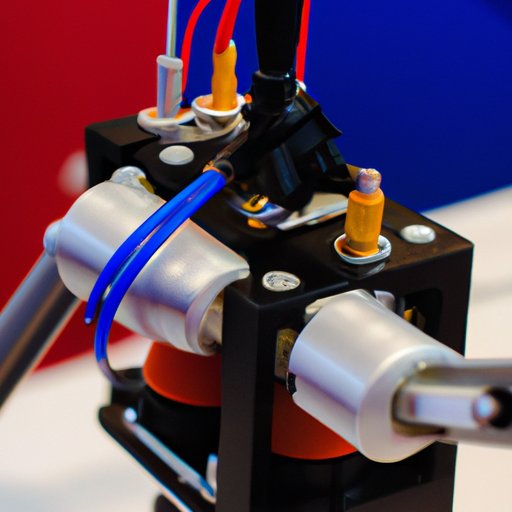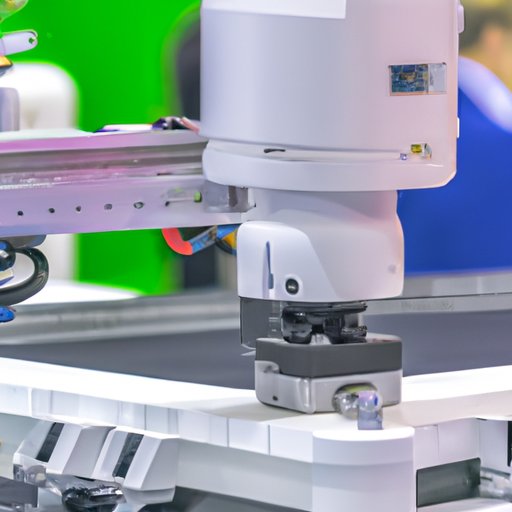An Overview of Robotic End Effectors: What They Are and How They Work
Robotic end effectors are devices used to interact with the environment, allowing robots to manipulate objects in a variety of ways. End effectors come in many shapes and sizes, but all serve the same purpose: to enable robots to perform tasks that would otherwise be too complex or dangerous for humans to do. In this article, we will explore what robotic end effectors are, how they work, and the different types available.

Definition of a Robotic End Effector
According to the Robotics Industries Association (RIA), a robotic end effector is “a device that is mounted on the end of a robot’s arm or wrist and used to manipulate objects in the environment.” End effectors can come in many forms, from simple mechanical grippers to complex multi-axis tool changers. No matter what type of end effector is used, each one serves the same purpose: to enable robots to interact with their environment in a meaningful way.

Components of a Robotic End Effector
Robotic end effectors typically consist of three main components: an actuator, a controller, and a sensor. The actuator is responsible for providing the force necessary to move and manipulate objects. The controller is what tells the end effector what to do and when to do it. Finally, the sensor provides feedback to the controller so that it can adjust its behavior accordingly.
How Robotic End Effectors Work
Robotic end effectors are controlled by a computer program, which instructs them on when and how to move. When an end effector receives instructions from the computer, it sends signals to the actuator, which then moves the end effector accordingly. The sensor then provides feedback so that the end effector can make adjustments as needed. This process is repeated over and over until the desired task is completed.

Exploring the Different Types of Robotic End Effectors
Robotic end effectors come in many shapes and sizes, and each one has its own unique set of features and capabilities. Here, we will explore four of the most common types of end effectors: grippers, rotary actuators, vacuum pods, and tool changers.
Grippers
Grippers are one of the most basic types of robotic end effectors. They use two or more fingers to grab and hold onto objects. Grippers are typically used in applications where precision is not necessary, such as assembly line tasks. According to a study published in the International Journal of Advanced Robotic Systems, “Gripper end effectors are the simplest and most common end effectors used in industrial robots.”
Rotary Actuators
Rotary actuators are end effectors that use rotating motion to move objects. These end effectors are often used in applications that require precise positioning, such as material handling or welding. Rotary actuators are also capable of performing continuous rotation, making them well suited for tasks that require repetitive motions.
Vacuum Pods
Vacuum pods are end effectors that use suction to pick up and move objects. Vacuum pods are typically used in applications where speed is important, such as packaging or material handling. According to a study published in the International Journal of Advanced Robotic Systems, “Vacuum pods are well suited for applications requiring high speed and accuracy.”
Tool Changers
Tool changers are end effectors that are capable of changing tools quickly and easily. Tool changers are useful in applications that require multiple tools, such as product inspection or machine loading. According to a study published in the International Journal of Advanced Robotic Systems, “Tool changers allow robots to switch between various tools quickly and easily, thus increasing the versatility of the robot.”
A Guide to Choosing the Right Robotic End Effector for Your Application
Choosing the right robotic end effector for your application can be challenging, as there are many factors to consider. Here, we will explore some of the key considerations for choosing the right end effector for your needs.
Considerations for Choosing the Right End Effector
When choosing the right end effector for your application, there are several factors to consider. First, you need to think about the task at hand and what type of movement is required. For example, if you need to grab and move objects, then a gripper might be the best option. If you need to position objects precisely, then a rotary actuator might be a better choice. You should also consider the size and weight of the objects being manipulated, as this will determine the type of end effector you need.
Cost Considerations
Cost is another important factor to consider when choosing the right robotic end effector. End effectors can range in price from a few hundred dollars to tens of thousands of dollars. It is important to consider your budget and choose an end effector that meets your needs without breaking the bank.
Safety Considerations
Safety is always a top priority when working with robots. It is important to choose an end effector that is designed with safety in mind. Look for end effectors that have built-in safety features, such as emergency stop buttons or sensors that detect when an object is too close to the robot.
Performance Considerations
Finally, you should consider the performance of the end effector. Look for end effectors that are designed for high performance and reliability. You should also consider how easy the end effector is to maintain and repair, as this will affect the overall cost of ownership.

The Benefits of Using Robotic End Effectors in Industrial Automation
Robotic end effectors offer numerous benefits for industrial automation. From increased efficiency to improved quality control, here are some of the key benefits of using robotic end effectors.
Increased Efficiency
Robotic end effectors can help to increase efficiency in industrial automation. By automating tedious and time-consuming tasks, end effectors can help to reduce cycle times and increase throughput. According to a study published in the International Journal of Advanced Robotic Systems, “Robotic end effectors can significantly increase the efficiency of production processes.”
Improved Quality Control
Robotic end effectors can also help to improve quality control in industrial automation. By automating tasks that require precision and accuracy, end effectors can help to reduce errors and improve the overall quality of products. According to a study published in the International Journal of Advanced Robotic Systems, “Robotic end effectors can help to ensure higher levels of quality control in automated processes.”
Enhanced Productivity
Robotic end effectors can also enhance productivity in industrial automation. By enabling robots to perform tasks more quickly and accurately, end effectors can help to increase output and reduce costs. According to a study published in the International Journal of Advanced Robotic Systems, “Robotic end effectors can help to increase productivity by reducing cycle times and improving accuracy.”
Reduced Labor Costs
Finally, robotic end effectors can help to reduce labor costs in industrial automation. By automating tedious and time-consuming tasks, end effectors can help to reduce the amount of manual labor needed, resulting in lower labor costs. According to a study published in the International Journal of Advanced Robotic Systems, “Robotic end effectors can help to reduce labor costs by eliminating the need for human operators.”
The Future of Robotic End Effectors: What Trends are Emerging?
Robotic end effectors are constantly evolving, and new technologies are emerging that promise to revolutionize the way robots interact with their environment. Here, we will explore some of the key trends that are emerging in the field of robotic end effectors.
Autonomous End Effectors
One of the key trends in robotic end effectors is the development of autonomous end effectors. Autonomous end effectors are capable of operating without direct human intervention, allowing them to adapt to changing conditions and respond to unexpected events. According to a study published in the International Journal of Advanced Robotic Systems, “Autonomous end effectors are becoming increasingly popular due to their ability to operate independently and react to changing environments.”
Integration with AI
Another trend in robotic end effectors is the integration of artificial intelligence (AI). AI can be used to improve the performance of end effectors by enabling them to learn from their environment and make decisions based on data. According to a study published in the International Journal of Advanced Robotic Systems, “AI-driven end effectors are becoming increasingly popular due to their ability to learn from their environment and make decisions based on data.”
Improved Versatility
Finally, end effectors are becoming increasingly versatile. New technologies, such as tool changers, are allowing end effectors to quickly and easily switch between multiple tools. This allows robots to perform a wide range of tasks with a single end effector. According to a study published in the International Journal of Advanced Robotic Systems, “Tool changers are becoming increasingly popular due to their ability to quickly and easily switch between multiple tools, thus increasing the versatility of the robot.”
How Robotic End Effectors Can Improve Productivity and Efficiency in Manufacturing
Robotic end effectors can have a significant impact on productivity and efficiency in manufacturing. Here, we will explore some of the key ways in which end effectors can improve productivity and efficiency in manufacturing.
Reduction in Human Error
Robotic end effectors can help to reduce human error in manufacturing. By automating tasks that require precision and accuracy, end effectors can help to reduce errors and improve the overall quality of products. According to a study published in the International Journal of Advanced Robotic Systems, “Robotic end effectors can help to reduce errors by automating tasks that require precision and accuracy.”
Increased Precision
Robotic end effectors can also help to increase precision in manufacturing. By automating tasks that require precise positioning, end effectors can help to reduce cycle times and increase throughput. According to a study published in the International Journal of Advanced Robotic Systems, “Robotic end effectors can help to increase precision by automating tasks that require precise positioning.”
Faster Production Times
Robotic end effectors can also help to reduce production times. By automating tedious and time-consuming tasks, end effectors can help to reduce cycle times and increase throughput. According to a study published in the International Journal of Advanced Robotic Systems, “Robotic end effectors can help to reduce production times by automating tedious and time-consuming tasks.”
Increased Flexibility
Finally, robotic end effectors can help to increase flexibility in manufacturing. By enabling robots to quickly and easily switch between multiple tools, end effectors can help to increase the versatility of the robot. According to a study published in the International Journal of Advanced Robotic Systems, “Robotic end effectors can help to increase flexibility by enabling robots to quickly and easily switch between multiple tools.
(Note: Is this article not meeting your expectations? Do you have knowledge or insights to share? Unlock new opportunities and expand your reach by joining our authors team. Click Registration to join us and share your expertise with our readers.)
